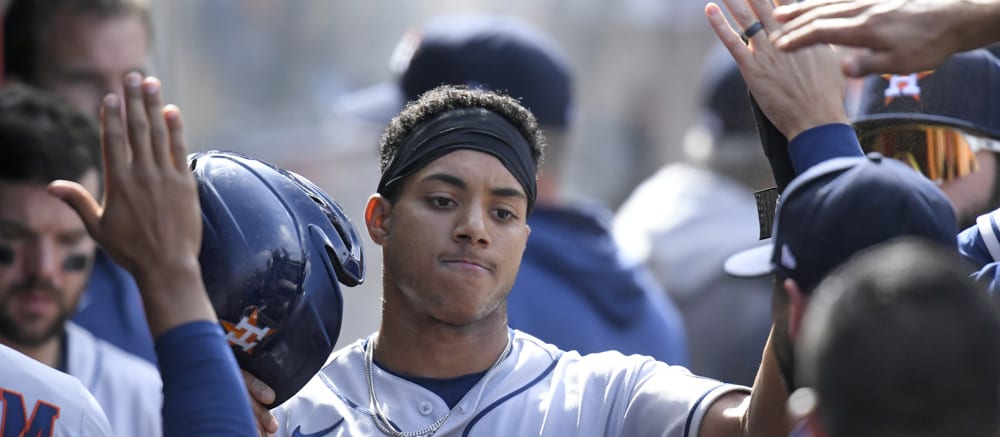Editor's Note: Stats in this article are updated through Monday, May 2, 2022.
One of the early metrics I'll scan is a hitter's chase rate. Sometimes a more aggressive approach isn't awful, assuming the hitter makes a healthy amount of contact. Yes, the contact quality matters and a hitter's pull rate affects the exit velocities. It just so happens that these three hitters rock higher chase rates and pull rates. Like most research, it starts with one idea, then spirals into other areas. Let's examine how the increased chase and pull rates impact these three hitters.
Jeremy Pena (SS - HOU)
The rookie shortstop has batted primarily towards the bottom third of the lineup. However, Pena batted leadoff in four straight games from April 19-23. In Triple-A in 2021, Pena flashed some power and speed with 10 home runs and five stolen bases, plus a .287 batting average in 133 plate appearances. The 26.3% strikeout rate and 4.5% walk rate in Triple-A led to potential swing-and-miss concerns.
Through 90 plate appearances, Pena has four home runs with a .215 batting average. It's early, but the 7.8% walk rate and 24.4% strikeout rate remain serviceable. Pena has stood out in terms of plate discipline with an above-average chase rate at 36%, yet an above-average Z-Contact% of 90.3%. With an early chase rate about five percentage points higher than the league average, he has a more aggressive approach. Thankfully, Pena is about league average or just north of that in terms of
Editor's Note: Stats in this article are updated through Monday, May 2, 2022.
One of the early metrics I'll scan is a hitter's chase rate. Sometimes a more aggressive approach isn't awful, assuming the hitter makes a healthy amount of contact. Yes, the contact quality matters and a hitter's pull rate affects the exit velocities. It just so happens that these three hitters rock higher chase rates and pull rates. Like most research, it starts with one idea, then spirals into other areas. Let's examine how the increased chase and pull rates impact these three hitters.
Jeremy Pena (SS - HOU)
The rookie shortstop has batted primarily towards the bottom third of the lineup. However, Pena batted leadoff in four straight games from April 19-23. In Triple-A in 2021, Pena flashed some power and speed with 10 home runs and five stolen bases, plus a .287 batting average in 133 plate appearances. The 26.3% strikeout rate and 4.5% walk rate in Triple-A led to potential swing-and-miss concerns.
Through 90 plate appearances, Pena has four home runs with a .215 batting average. It's early, but the 7.8% walk rate and 24.4% strikeout rate remain serviceable. Pena has stood out in terms of plate discipline with an above-average chase rate at 36%, yet an above-average Z-Contact% of 90.3%. With an early chase rate about five percentage points higher than the league average, he has a more aggressive approach. Thankfully, Pena is about league average or just north of that in terms of contact.
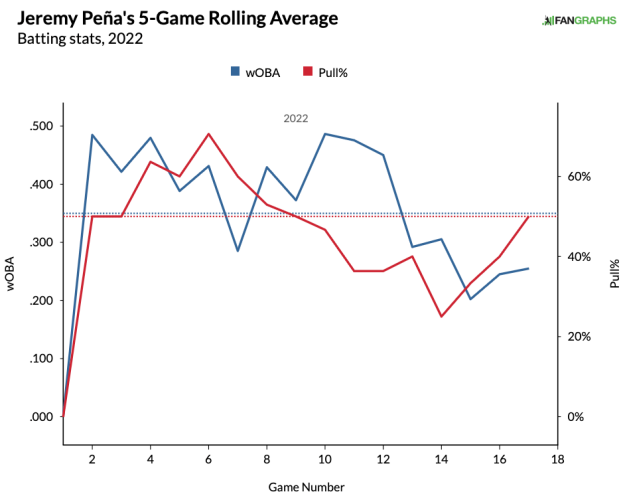
At Triple-A, Pena boasted a high groundball rate at 48.8%, which isn't uncommon with young hitters. However, in the early 2022 sample, Pena rocks a 39.3 GB% while trading those line drives for flyballs with a 44.6 FB%. That's notable, especially because Pena's Pull% of 48.3% indicates an attempt to tap into the pull side power.
Pena's Statcast Data
Where Pena also pops is the Statcast data and hard-hit metrics -- 15.5 Barrel% (89th percentile) and 10% Barrel/PA. The 48.3% hard-hit rate (80th-percentile) and 110.3 mph maximum exit velocity (76th-percentile), plus the 96 mph EV on FB/LD (No. 33), give a glimpse of the raw power.
Even if Pena slumps, the 98th-percentile Outs Above Average should keep him in the Astros' lineup with the plus defense. Yes, it's a small sample of teams shifting in 90 plate appearances, but Pena's .177 wOBA versus the shift will be worth monitoring, given the high pull rates.
Takeaways
When James Anderson talks, we listen, particularly when it comes to prospects like Pena. The positive outlook on Pena via James should give us confidence if you roster him. Given the early plate discipline metrics, it seems like Pena might provide more value in batting-average leagues than OBP formats. The OBP has dropped to .291, and the chase rate hints at the on-base skills not being above average right now.
So far, the barrel rate and exit velocity on flyballs and line drives provide reason for optimism. However, Pena hasn't even tapped into the stolen-base ability much yet. It's partially the Astros' lineup context since the 55% stolen base rate ranks the team bottom six in the league.
Hunter Dozier (3B/OF - KC)
Before the season started, Dozier landed in my debut article, when I discussed three potential hitter values. Dozier dealt with a thumb injury and COVID-19 in 2021, which likely impacted the power and overall production. It's early, but Dozier has batted sixth in nearly every game in 2022, with three home runs and a .225 batting average. Oddly, Dozier has only walked twice (2.7%), leading to a .257 OBP.
Dozier's Batted-Ball Profile
So far, Dozier's Pull% is up to 52.9%, over 10 percentage points above his career rate of 41.4%. The batted-ball profile looks similar, with a 44 FB%, three percentage points higher than the career averages. Oddly, the .470 wOBA versus the shift jumped back up near the 2019 numbers of .484, though it's a small sample in 2022.
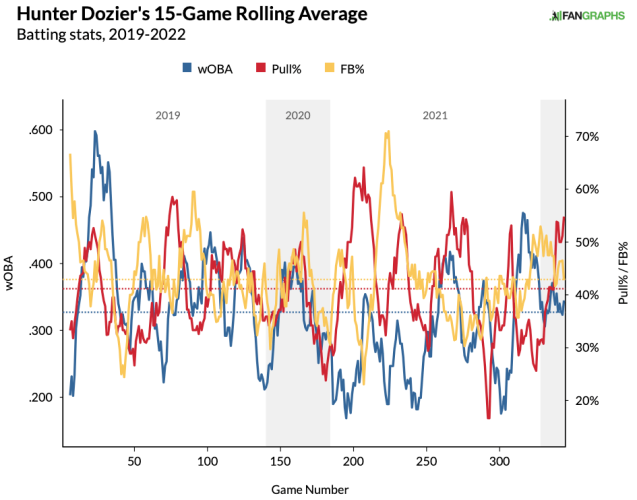
With Dozier's pull-heavy flyball approach, his early 22.7% infield flyball rate looks scary, but that should regress closer to the career rate of 10.5%. Dozier might be attempting to sell out for power early on in 2022.
- 2022: 34.1 degrees sd(LA), 24.5% Dynamic Hard-Hit%
- 2021: 27.4 degrees sd(LA), 15% Dynamic Hard-Hit%
- 2020: 28.2 degrees sd(LA), 11% Dynamic Hard-Hit%
- 2019: 27.8 degrees sd(LA), 16.4% Dynamic Hard-Hit%
The increased launch angle led me to check the standard deviation of launch angle or sd(LA). From 2019 to 2021, Dozier rocked an sd(LA) of 27.7 degrees. During that timeframe, hitters with a similar sd(LA) include Salvador Perez, Bo Bichette, and Jorge Polanco. A hitter should have a "tighter" launch angle or lower sd(LA), per Alex Chamberlain.
Unfortunately, the early 2022 sd(LA) looks scary at 34.1 degrees, so hopefully, Dozier's sd(LA) becomes more consistent. We included Dynamic Hard-Hit% because Connor Kurcon and Alex Chamberlain note that hard-hit rates vary based on the launch angle. It makes sense to see Dozier's DHH% increase with the looser sd(LA), with the increased flyballs and pull rates.
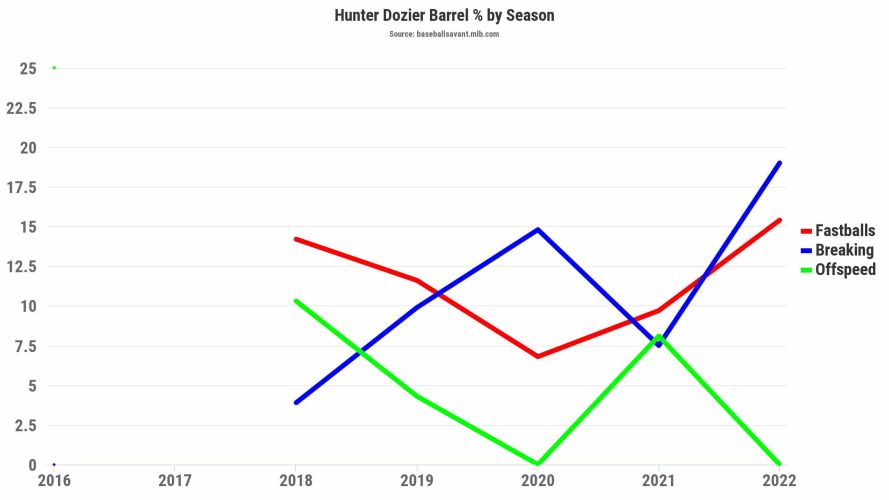
All that data aligns with Dozier's 15.7 Barrel% (90th percentile) and 10.8% Barrel/PA. It seems likely that those numbers will regress, but it's positive to see the power output in 2022. Also, Dozier's 95.8 mph EV on FB/LD (No. 59) looks juicy. In Dozier's peak 2019 season, he rocked a 94.2 mph EV on FB/LD (No. 47).
Dozier's Aggressive Approach
With the eye-popping walk rate (and not in a good way), Dozier's plate discipline raises eyebrows. Dozier has a 39.2 O-Swing%, over six percentage points above his career average, which likely regresses with more plate appearances. Or there's a chance Dozier attempts to be more aggressive with a 55.2% Swing%.
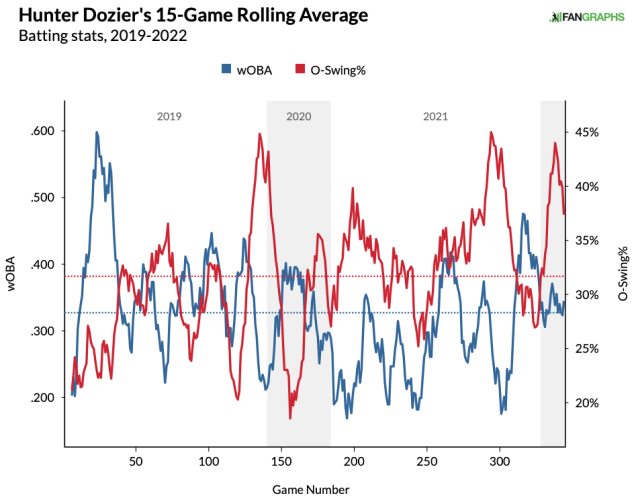
Thankfully, Dozier rocks an 86.5 Z-Contact%, but he still makes below-average overall contact with a 71.1 Contact%. It's an intriguing approach, but hopefully, that doesn't lead to the strikeout rate jumping to a point where the batting average becomes a liability.
Takeaways
The early season production in home runs and batting average provide optimism, especially since it's backed up via the skills and hard-hit metrics. Unfortunately, the Royals' offense hasn't performed well, with a 78 wRC+ (No. 28), .272 wOBA (No. 27), and .595 OPS (No. 29). Monitor Dozier's plate discipline and pull rates because they are different from his career norms.
Cristian Pache (OF - OAK)
The Oakland Athletics made it clear this past offseason that they're selling their core players. A defense-first prospect, Pache struggled in the majors (2020-21) with one home run, a .119 batting average, .162 wOBA, and -6 wRC+ in 72 plate appearances. With the small sample, it's hard to glean any takeaways from Pache's skills and performance.
Oakland will play Pache nearly daily, although the lineup spot at ninth or the bottom third means it's wise to scale back any counting stat expectations. Through 74 plate appearances, Pache has two home runs with a .194 batting average. Like Dozier, Pache has barely walked, with a 2.7% walk rate.
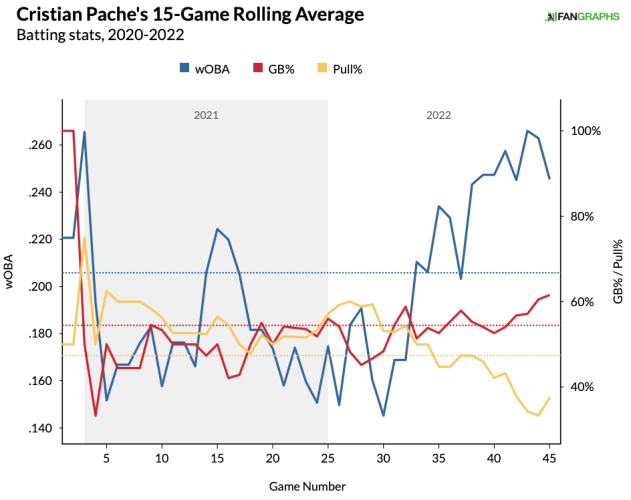
Unsurprisingly, Pache's 55.6 GB% and 41.8 Pull% align with the minor-league trends. At Triple-A in 2021, Pache had a 46.5 GB% and 47.1 Pull%. Whenever a hitter rocks a higher ground ball rate, they need to possess a high EV on FB/LD like Juan Soto at 98.7 mph (No. 9) and Yandy Díaz at 95.9 mph (No. 54). Although Pache's 95.4 mph EV on FB/LD (No. 74) isn't eye-popping, it's still above average amongst qualified hitters with 25 batted ball events.
Pache's Aggressiveness & Hidden Power
Like Dozier, Pache boasts an aggressive approach with a 41.6 O-Swing% and 54.6 Swing%, above the league averages. Pache is making about league-average contact, and perhaps, the contact quality metrics will remain solid.
It's hard to compare with past seasons, but Pache's early 9.1 Barrel% (61st percentile) and 6.8% Barrel/PA stand out. Even the 49.1% hard-hit rate (85th percentile) makes us take a second look, but the 107.6 mph maximum exit velocity (50th percentile) remains underwhelming.
Takeaways
Given Pache's profile, he probably provides more real-life than fantasy value. It's reasonable to expect Pache to accumulate plate appearances (as he should), meaning he could compile double-digit home runs and stolen bases. Overall, Pache's power metrics provide optimism, but the plate discipline and heavy ground ball rates concern us.


